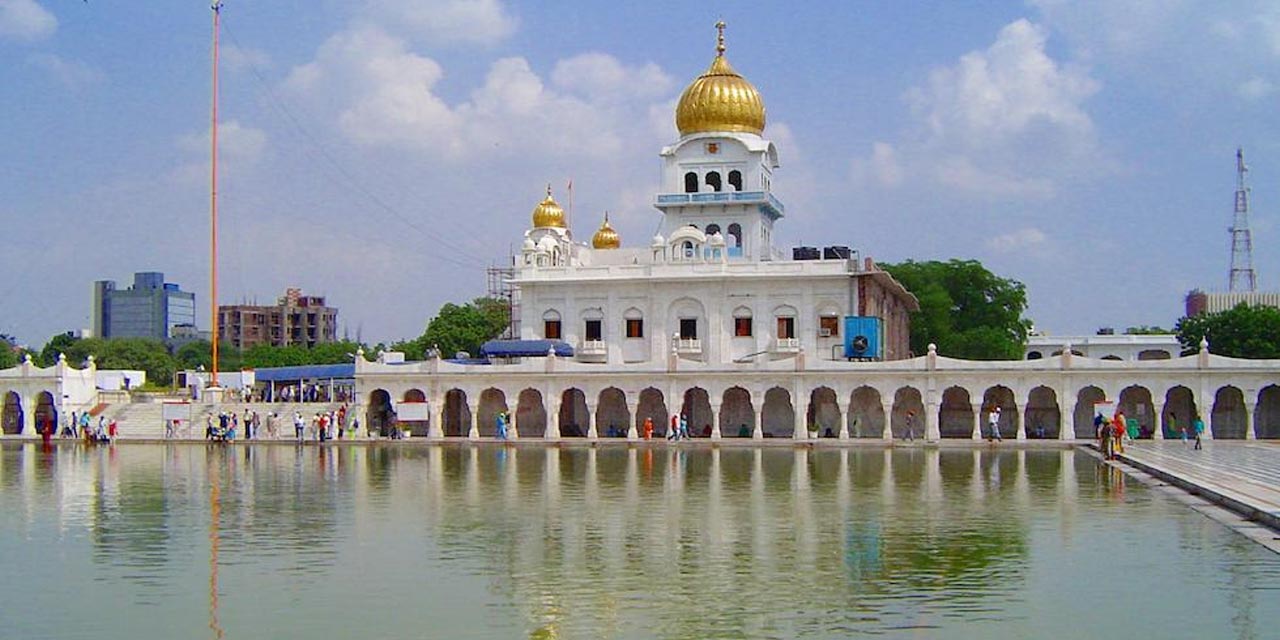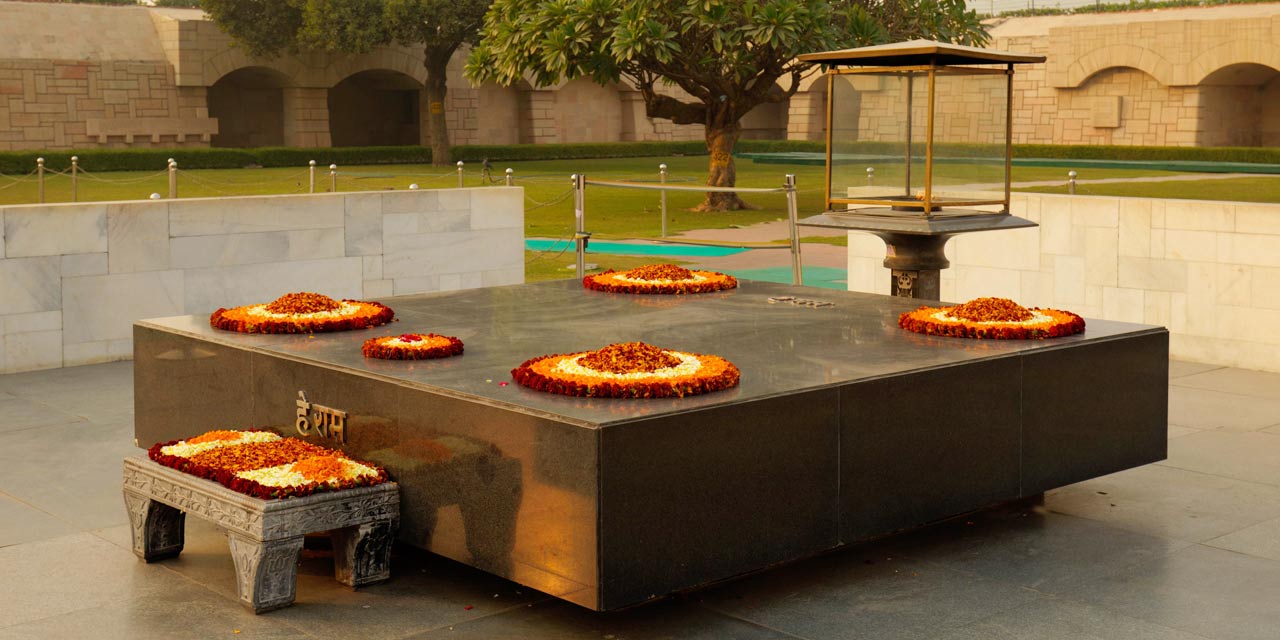Best Place to travel in India from Delhi
Our India
Travel in Delhi
The capital of India, Delhi is a cosmopolitan city with a historic old Delhi and the modern New Delhi. From historical monuments to crowded shopping malls, from an extensive network of the modern metro system to Delhi University campus, Dilli has multiple personalities and is considered to be the city with a heart.

India Gate
The India Gate is a war memorial near the Rajnath, on the eastern edge of the "ceremonial axis" of New Delhi, previously called Kingsway in memory of 84,000 soldiers of the British Indian Army who died between 1914 and 1921 in the First World War. It was designed by Sir Edwin Lutyens. Amar Jawan Jyoti or the flame of the immortal soldier located near India gate, is s a structure consisting of black marble plinth, with reversed rifle gun, capped by war helmet, bound by four urns, each with the permanent light from compressed natural gas flames to commemorate Indian soldiers martyred in the war of the liberation of Bangladesh in December 1971. The Rajpath is a long and clear road that leads up to the India Gate. The Annual Republic Day parade passes through this site. One can enjoy nearby fountains. A beautiful display of water and lights in the evening.


Red Fort
The Red Fort (Lal Qila) is a historic fort in the city of Old Delhi which served as the main residence of the Mughal Emperors. On 15 August 1947, the first Prime Minister of India, Jawaharlal Nehru, raised the Indian flag above the the main gate,Lahori Gate. Every year on India's Independence Day (15 August), the Prime Minister hoists the Indian tricolour flag at the fort's main gate and delivers a nationally broadcast speech from its ramparts. The Red Fort was designated a UNESCO World Heritage Site in 2007 as part of the Red Fort Complex. The World Heritage Convention characterises the Red Fort as representing "the zenith of Mughal creativity". The fort synthesizes Islamic palace structure with local traditions, resulting in mix of "Persian, Timurid, and Hindu architecture".


Qutub Minar
The Qutb complex are monuments and buildings from the Delhi Sultanate at Mehrauli in Delhi in India. It is the second tallest Minar in India after Fateh Burj in Chappar Chiri at Mohali, measures 100 meters in height. It is a UNESCO World Heritage Site. The victory tower is a symbol of the synthesis of traditional Islamic architecture and Southwestern Asian design.


Rashtrapati Bhavan
The Rashtrapati Bhavan is the official residence of the President of India at the western end of Rajpath in New Delhi, India. This building which was completed in 1929 was meant to be the seat of the Viceroy in the British period in India. It is located on Raisina hill and is a beautiful sprawling edifice with 340 different rooms built in to meet any social or political needs. There are beautiful domes and statues and sculptures of animals adorning the building on all sides. It holds the highest importance in politics in India and stands in honor of the world’s largest democracy. The Mughal gardens is open to the public in the month of February when the flowering plants are at their beautiful best.


Lodhi Garden
Also known as Lady Willingdon Park, Lodhi Gardens is an eye-catching park, located in the New Delhi. It is located between the Khan Market and the Safdarjung Tomb. Lodi Gardens present an impressive blend of lush greenery and majestic architectures which belong to 15th and 16th century. It is a perfect spot for those seeking some peaceful time amid the refreshing nature and Sunset is especially breathtaking at the Lodhi Gardens.


Lotus Temple
The Lotus Temple is a Baháʼí House of Worship that was dedicated in December 1986. It is in flowerlike shape. It is open to all regardless of religion. The building is composed of 27 free-standing marble-clad "petals" arranged in clusters of three to form nine sides, with nine doors opening onto a central hall with a height of slightly over 34 meters and a capacity of 1,300 people. All Baháʼí Houses of Worship share certain architectural elements, some of which are specified by Baháʼí scripture. ʻAbdu'l-Bahá, the son of the founder of the religion, wrote that Baháʼí Houses of Worship must be nine-sided and circular. The permanent delegation of India to UNESCO stated that the Lotus Temple had visited over 100 million visitors by April 2014.


Swaminarayan Akshardham Temple
Swaminarayan Akshardham is a Hindu temple, and spiritual-cultural campus. It is close to the border with Noida. Akshardham Temple God is Bhagwan Swaminarayan. It is also dedicated to great saints, devas and averts of Hindu Gods. It was inaugurated by Dr. A.P.J. Abdul Kalam in 2005. Built on to Vastu shastra and Pancharatra Shastra, Akshardham Delhi presents a traditional architecture of Hindu Temples. It has also been bestowed with Guinness world record for being the largest comprehensive Hindu Temple in the world.


National Museum
The National Museum, also known as the National Museum of India, is one of the largest museums in India. It is established in 1949, it holds a variety of articles ranging from pre-historic era to modern works of art. The museum has around 200,000 works of art, mostly Indian, but some of foreign origin, covering over 5,000 years. The collections of the National Museum represent almost all disciplines of art: archaeology (sculptures in stone, bronze and terracotta), arms, armour, decorative arts, jewellery, manuscripts, miniatures and Tanjore paintings, textiles, numismatics, epigraphy, Central Asian antiquities, anthropology, Pre-Columbian American and Western Art Collections.


Garden of Five Senses
The Garden of Five Senses is a paradise for nature lovers, away from the city center. It is a mixture of natural beauty and man-made art. It is a park sprawling over 20 acres; built partly on rocky terrain and partly on a plain area. This beautiful park has trees, flowery bushes and other plants. And you’ll also come across water fountains and pools.


Humayun's Tomb
Humayun's tomb is the tomb of the Mughal Emperor Humayun in Delhi, India, was commissioned by Humayun's first wife and chief consort, Empress Bega Begum under her patronage, designed by Mirak Mirza Ghiyas and his son, Sayyid Muhammad. It was the first garden-tomb on the Indian subcontinent,[ and is located in Nizamuddin East, close to the Dina-panah Citadel, also known as Purana Qila (Old Fort), that Humayun found in 1538. The several smaller monuments dot the pathway leading up to it, from the main entrance in the West, including one that even pre-dates the main tomb itself, by twenty years.


Shankar International Dolls Museum
Shankar's International Dolls Museum, this attraction is the biggest doll museum in the country. The collection inside is not only of dolls from India but also many other countries, lending it the international character that it is famous for. The museum has a single floor in the Children’s Book Trust Building near Ram Charan Agrawal Marg. It has two same size sections, and each half has a vast collection of dolls from selected regions of the world.


Gurudwara Bangla Sahib
No matter what religious belief you follow, Gurudwara Bangla Sahib in Delhi is a must-visit place for you. It is one of the most famous Sikh Gurdwaras in the city as well as in the country. It is known for its association with eighth Sikh Guru, Guru Har Krishan Singh. Built as a small shrine by Sikh General Sardar Baghel Singh in 1783, Gurudwara Bangla Sahib is situated on Baba Kharak Singh Marg in Connaught Place, New Delhi. Its golden dome and a large flagpole called Nishan Sahib make you recognize the place from a distance too. It is interesting to note that Gurudwara Bangla Sahib was originally a bungalow, that belonged to Raja Jai Singh and was known as Jaisingh Pura palace. It is believed that Guru Har Krishan Singh used to reside in the bungalow during his stay in Delhi in 1664.


Lakshmi Narayan Temple
Better known as Birla Temple, the Lakshmi Narayan Temple is dedicated to Lord Lakshmi Narayan. Lakshmi Narayan refers to Lord Vishnu, also known as Narayan when he is with his consort Lakshmi. Although a Hindu temple, it is open to people of all religions and castes. Built by industrialist Baldeo Das Birla and his sons, the temple was inaugurated by Mahatma Gandhi on the condition that it will be open for people of all religions. It was built from 1933 to 1939 and was the first large Hindu temple in Delhi. The Birla temple is spread over 7.5 acres of land and has a large garden, shrine, fountains, and a hall called Geeta Bhawan for discourses. The temple is a significant attraction for tourists and localites on special occasions like Janmashtami and Diwali.


Raj Ghat
In the older part of Delhi, lies a cool and calm place called the Raj Ghat. Raj Ghat is a memorial dedicated to the Father of the Nation Mahatma Gandhi. It is a black marble platform, built on the spot of Mahatma Gandhi’s cremation. It was built on 30th January 1948, a day after his assassination. The memorial is left open under the sky, and an eternal flame burns on end. Located on the banks of River Yamuna, Raj Ghat is situated on Mahatma Gandhi Road. The place is high on the list of politicians, state guests, and historians. One must remove his shoes before entering the walls of the Raj Ghat. Outside the walled architecture, is a lawn with some natural greenery.

